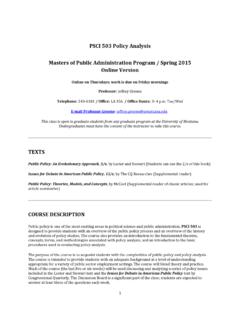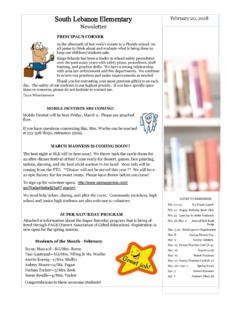Transcription of *delivered at Dumisani Theological Institute, King …
1 Ntsikana By. Dr. John S. Ross *delivered at Dumisani Theological institute , king william s Town, SA, march , 2015 The First Years Ntsikana was born around 1780. He was the son of Gaba, a councillor to the important western amaRarhabe king , Ngqika. His mother was Gaba s Right Hand (junior) wife, Nonabe, who, it is believed, brought up Ntsikana among her people until the boy was was about five or six. Tradition suggests that because his father s Great Wife, Noyiki, had a daughter but no sons, she adopted Ntsikana who therefore became Gaba s heir. From this time on, Ntsikana s home was the beautiful Thyume valley, north of It was around the time of Ntsikana s circumcision that he first came in touch with the Christian gospel. In 1799, during a time of great tension and open warfare on the border of the Cape Colony, Johannes van der Kemp, a missionary of the London Missionary Society, arrived among the western amaXhosa and was permitted to set up his camp near to Ngqika s Great Place.
2 Van der Kemp was not the kind of white man with which the Xhosa had become familiar. Instead of adopting a European lifestyle, van der Kemp ate Xhosa food and slept in a Xhosa hut. Future Xhosa leader, Dyani Tshatshu, who was to become closely associated with the London Missionary Society, remembered him as the one who travelled on foot, without hat, shoes or Van der Kemp soon became an attraction both for the king and his people, and in the year that he remained among them they had many opportunities of hearing him preach and of discussing with him his new teaching. They appreciated his emphasis on a spiritual experience of God and the possibility of a new birth, rather more than his strange ideas and hard to understand foreign doctrines. When van der Kemp departed from the area at the end of 1800, he could 1 Vuyani Booi, Ntsikana , in Ed. Mcebisi Ndletyana, African Intellectuals in 19th and Early 20th Century South Africa (Cape Town: HSRC Press, 2008), 2 Jeff Peires, The House of Phalo: The History of the Xhosa People in the days of their Independence (Johannesburg and Cape Town: Jonathan Ball Publishers, 2003 ed.)
3 , claim no converts from among the Xhosa, though he had not left without influence. Indeed, a strong tradition holds that Ntsikana, who had been herding the king s cattle, first heard the gospel as he sat on the edge of a crowd who were listening to the missionary. So it may well have been van der Kemp who first inspired Ntsikana to give his poetry and teaching a Christian content as he travelled the country praising God and What passed through Ntsikana s mind at this time is, of course, hidden from us. To all outward appearances he continued as a normal Xhosa lad, passing through circumcision to manhood and by going quietly about his business as a respected but unremarkable homestead-head, enjoying what he had inherited of his father s holdings and contently married to two wives. Spiritual experiences Like traditional diviners, Ntsikana was susceptible to spiritual traces and mystical experiences, which he referred to as this thing which he couldn t ignore.
4 Later he believed that through these experiences God was calling him to be a Christian. His most famous experience was when he was at the kraal looking contentedly at his much loved prize ox, Hulushe. As he watched, he was intrigued to see a patch of light, brighter than ordinary sunlight, illuminating the hide of the animal. So remarkable was the sight that he turned to his companion, a young herd, to ask for corroboration. But, no, the lad had to admit that he had not seen anything unusual. Recovering from the trance, Ntsikana remarked, No, you are right. The sight was not for your eyes. The experience was interpreted by A. C. Jordan, a Xhosa novelist and teacher, as an inner illumination of soul, the dawning on Ntsikana that his life s task was to spread the light of God to others, though at the time it seems he was unclear that that light was in fact the Christian gospel. It took another experience later the same day to bring that home to him.
5 3 Cf. Booi, op. cit. and Ido H. Enklaar, Life and Work of Dr. J. Th. van der Kemp, 1747-1811 (Cape Town: A A Balkema, 1988), Cf. Ed. Timothy Keegan, Moravians in the Eastern Cape, 1828-1928: Four Accounts of Moravian Missionary Work on the Eastern Cape Frontier (Cape Town: Van Riebeeck Society, 2004), Ntsikana was an accomplished singer and highly regarded traditional dancer, who had often taken part in the ritual wedding dance, the umdudo. On the afternoon of the day when Ntiskana had seen his ox transformed by a vision of light, he was attending a wedding party and it came as a great surprise to his companions when he refused to take part in the dance. Disappointed they would not see his contribution, the party insisted he took part. Ntsikana eventually conceded and produced a tremendous performance. But even as he danced a storm broke, with a powerful wind, flashes of lightening and deep rumbles of thunder.
6 As he sat down, so the storm subsided, only to begin all over again when he once more stood up to dance. John Knox Bokwe connects the two visions: Ntsikana returns to his seat, as crest-fallen as ever; and the wind ceases. A third time, he gets up, and a third time this horrid gale arises as furiously as ever. The interested and superstitious gazers exchange looks of astonishment at this strange occurrence repeating itself each time the son of Gaba rises to join the dance! Who has bewitched him? All at once, the vision of bright rays which he saw in the morning shining gloriously on the side of his favourite ox, Hulushe, is recalled to his remembrance, and without a single word of explanation, or apology to any one, he orders his people to get ready to return home! All of them, surprised, and whispering puzzled enquiries as to the cause of so early a departure, obey the order and march home, greatly vexed that their pleasure had been so abruptly brought to an end, with no explanation hinted as to the reason why.
7 As they neared home, they came to a small river. Here Ntsikana threw aside his blanket, plunged himself into the water and washed off all the red ochre that painted his body. He then proceeded on his way, while his followers were yet more surprised at this additional strangeness and eccentricity of 4 John Knox Bokwe, Ntsikana: The Story of an African Convert (Alice: Lovedale Press, 1914) at accessed 24 June, 2014. The two gestures of washing off the red ochre and throwing away his blanket assumed a symbolic importance for Xhosa Christianity; they were to become the traditional expression of what Christian baptism symbolised: the turning from traditional religion to embrace the gospel of Jesus Christ. For Ntsikana, there was no going back: committing himself to his new life, he renounced polygamy, making a generous settlement for his second wife, Nomonto.
8 A more excellent way At this point in his experience, Ntsikana could be likened to Apollos, the first century Alexandrian Jewish Christian mentioned in the Acts of the Apostles. In chapter 18 we read of Apollos coming to Ephesus enthusiastic to teach the things concerning Jesus . Although eloquent, competent in handling the Bible and skilled in communicating what he did know, there were important aspects of the Faith which he had yet to discover. A Christian couple, Priscilla and Aquila, became his mentors and took him aside and explained to him the way of God more accurately. Who would be Ntsikana s mentor? At this point two more missionaries of the London Missionary Society entered his life, James Read and Joseph Williams. Read s strong sympathies for the Khoi led his enemy, Sir George Cory, to call him the most dangerous and wicked man on the frontier. 5 Read's marriage in 1803 to a Khoi woman upset many whites and some of his LMS colleagues too.
9 As Christopher Saunders says, Put simply, [to the settlers and some of the missionaries] he seemed to commit the unforgivable sin of always being on the side of the blacks. 6 Williams, with his wife Elizabeth, had landed at Cape Town in 1814 and for a while settled at the Moravian missionary centre at Bethelsdorp where he met the young Dyani Tshatshu, son of the Xhosa chief whose village was on the 5 Cited by Christopher Saunders, James Read: Towards a Reassessment, typed manuscript at , accessed 24 July, 2014. 6 Saunders, op. cit. Buffalo River, near where king william s Town now stands. He became william s assistant and interpreter. In April 1816 Read, Williams and Tshatshu travelled east searching for a suitable place to establish a missionary station among the Xhosa. Their journey took them more or less along the line of the modern N2 road, crossing the Fish River, the boundary of the Colony, at Trompetter s Drift near Peddie, before turning north to reach the headwaters of the Keiskamma River.
10 After some difficulty locating the king , they were eventually granted permission to settle at Kat River, later renamed Fort Beaufort. Somewhere beneath the Amathole mountains, near the present town Read and Williams met Ntsikana, who shared with them what was on his heart. They listened keenly to what he said, offered words of encouragement and some further Scriptural teaching, before inviting him to travel with them back to Bethelsdorp when they retuned. But such a journey was impossible, neither his chiefs nor the British authorities would allow him to travel into the colony, so the missionaries advised him to remain where he was until Williams could return to establish the new mission station and offer him further instruction. 7 That night Ntsikana slept at the kraal of a local chief and shared what he understood of the gospel with them. Whenever he had attempted to speak of these things before he had been regarded as mad, but now the people realised that what he said was not madness at all, but believed it truly was the Word of God.






